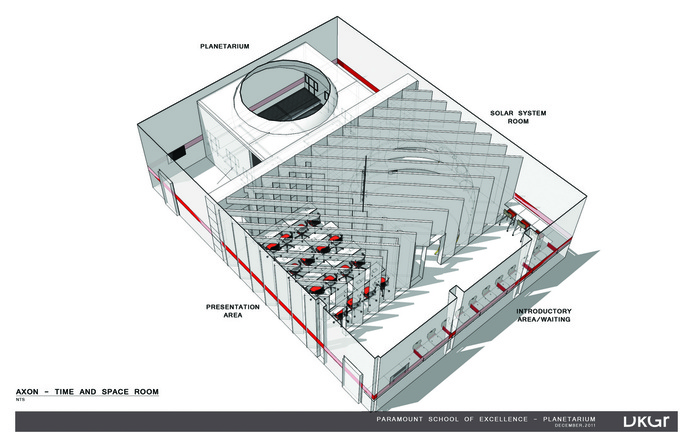 Dare to dream is a great motto when you get to bring a vision to reality. And, while it's not even remotely true to say I always get what I aim for, this new Time and Space Discovery Room (above) is a fun example of bringing a dream to life. Our school has claimed (in it's charter) that it will have three discovery rooms. One of those room is the Eco Room and is already complete. This second room is now coming to life after I shared my need for modern abstract angles, scientific discovery and a planetarium with Business Furniture and DKGR Architects. I credit our two partners with help in design and know-how. The end result will be a K-8 school with a Smithsonian Museum Style experience. Funding has been obtained through a State Innovation Fund Grant and the project has already begun (currently in the planning phase). Please follow our progress by visiting our project site at https://sites.google.com/a/dkgrar.com/pse---planetarium-project/home. Tommy Reddicks www.tommyreddicks.com
3 Comments
 When managing your class during instruction, there will often be times when you are faced with the dilemma of either discontinuing instruction because student behavior has begun to break down, or fighting through the storm to ensure content coverage. The trouble is discerning when it’s the appropriate time for each path. If this were an easy problem, we’d all be doing it perfectly. But, in education, the solution changes with the ability and capacity of the class, and is only brought into focus through the personality and wisdom of the educator. So, here are two steps and four simple focusing questions to ask in these moments: STEP ONE: Non-verbal Intervention 1) Have I tried non-verbal redirects, including (but not limited to) proximity, change of volume, lights, readers, touch, pointing, hand signs, etc.? If the answer is yes to the first question – move on to step two: STEP TWO: Assess the environment 2) Is the class engaged? 3) Can I be heard clearly? 4) Can I continue “my” flow with the lesson? If the answer is “no” to any of these questions, it may be time to rethink the “power through it” strategy. If the answer is "no", the teaching is no longer effective and learning is in jeopardy. From here, the teacher has only three options: lose control, try a quick redirect, or discipline the problem. Assuming most of us want to avoid losing control of the class, you have now reached the point of redirect (minor discipline or structured warning) or full-on discipline. I like to say it this way, “When teaching stops, discipline starts.” A good teacher should be able to manage with non-verbals and quick redirects through the majority of the day. But, if a student or students have broken down the lesson and teaching cannot continue, it is no longer time for a string of warnings or reminders, it’s time to discipline the source and protect the academic needs of the room. The other side to the same quote ("When teaching stops, discipline starts") is engagement. If your teaching (and planning) is not engaging, students will tune it out. When teaching has been tuned out, teaching has stopped and discipline will undoubtedly begin. Tommy Reddicks Indianapolis, IN
 It’s easy to self-declare leadership. Circumstance and confidence can propel many different people into leadership. It’s also easy to say, “Now there’s a good leader!” or, “that person would make a great leader”. But, it’s harder to say what leaders actually “do” that make them successful. Even harder, how do they maintain success over time? Whether intentionally or inherently, true leadership comes from a solid understanding of Group Dynamics. While many of us have not had formal training in Group Dynamics, it is essential that a rudimentary understanding be in place. If you look online you are likely to find a definition for Group Dynamics to be something like: Group dynamics refers to a system of behaviors and psychological processes occurring within a social group (intragroup dynamics), or between social groups (intergroup dynamics). The definitions can quickly become confusing psychobabble, so I like describing Group Dynamics as a simple balancing act. For instance, imagine balancing a marble on a wooden cutting board. As the marble starts to roll in any direction, you must compensate by lifting that edge of the board to stop the marble from falling off. Bringing the marble to a complete stop on the board means that you can effectively manipulate the height and angle of each side until balance is achieved through what you physically see and what you learn by moving the board (through muscle memory and trial and error). Effective leadership through Group Dynamics is not unlike this balancing act. The marble represents your human resources or human capital (your staff, students, and even parents). The cutting board represents your toolset (communication skills, rapport building, systems, protocols, etc.) and the individual trying to maneuver the cutting board to make the marble stop rolling is you, the leader. So, when asking how I define leadership? My simple answer is, “Balanced Group Dynamics”. Proper leadership has the capacity to bring the marble to a stop no matter how often the cutting board is adjusted, and how often the marble begins to roll in any errant direction. That involves efficient systems of communication, effective diplomacy, a driving sense of inspiration, and consistent follow through. Or, (in reduced psychobabble) dynamically operating a group so that all members of the group can move in the same direction, maintaining the system’s overall balance. So, the next time you recognize admirable leadership, stop for a moment and change your focus. Instead of focusing on the leader, watch the group being led. Look to see how the group is compensating and maintaining the stability of the system? Sometimes it is very obvious how group supports have been scaffolded and delegated, and other times, the dynamic is subtler. But, undoubtedly, the group is well trained and ready to ebb and flow as required. So, when you have begun to observe the group being led and are beginning to draw some conclusions, try this activity: Reflect on the procedures or protocols necessary for maintaining the balance demonstrated by the group. Then, try to write out a map of their system of supports or chain of command. Use a napkin, or a scrap of paper and map it out, or just simply play it out your mind. (I have found that this activity will hone your focus and will help refine your ability to inherently identify key components to successful systems in Group Dynamics.) Finish each reflection by asking yourself what role you would most comfortably play in that dynamic system of leadership. Would you be the marble, cutting board, or the leader? No matter what your answer, what would you do differently with your role in that system? In closing, successful leadership rarely happens accidentally. Effective leaders have an established system, where group dynamics ensure success over time. Poor leaders are architects of poor systems and will tend to swing unpredictably from extreme success to extreme failure, if they achieve success at all. When carving your own personal leadership style, investing energy into the study of behavioral systems and psychological processes (Group Dynamics) will yield high returns. Try to take a more intentional and investigative role in your own Group Dynamics. That focus will elevate your level of awareness of what is being done in “your” system to ensure the marble stays still. Over time, you may be surprised to find out that you have more control over that little marble than you ever thought was possible. Tommy Reddicks Indianapolis, IN
|
Categories
All
AuthorTommy Reddicks has been a teacher and administrator in Wyoming, Arizona, Washington, Colorado, and Indiana since 1995. Archives
July 2016
|